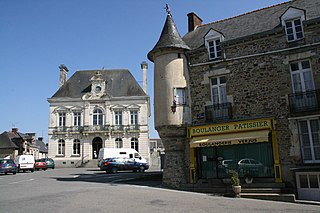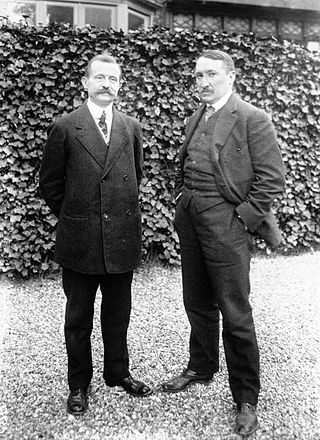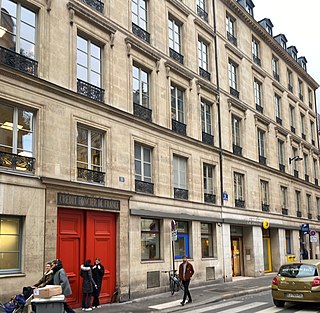Notes
- 1 2 Lucien Chaillou. "29 novembre 1951 Centenaire de la création de Boufarik". Bab el Oued Story.
- ↑ "Erection à Boufarik d'un monument à la gloire du génie colonisateur de la France". alger-roi.fr.
The Boufarik colonization monument was a monument celebrating French colonization in Boufarik, Algeria. It was erected in 1930 and demolished in 1962.
The monument was erected in 1930 to mark the 100th anniversary of the French Invasion of Algiers in 1830. Boufarik was chosen as its site because of its location at the heart of the fertile Mitidja plain, following a narrative according to which the region prosperous agriculture demonstrated the value of the colonization project.
The monument was designed by sculptors Henri Bouchard and Charles Bigonet with architect Xavier Salvador, in the Art Deco style that was dominant at the time. On 20 November 1929, their project won the design competition organized by the Conseil supérieur du centenaire that coordinated the centenary celebrations. It took the shape of a massive wall, 9 meters high and 45 meters wide, [1] at the western end of Boufarik's main thoroughfare, now N61 road, whose eastern end was (and still is) the town's central church. On the wall stood an inscription in colossal capital letters, "[dedicated] to the French colonizing genius" (French : au génie colonisateur français), with a text in smaller letters beneath that read "to the heroes, to the pioneers of civilization, to the makers of greater France" (French : aux héros, aux pionniers de la civilisation, aux réalisateurs de la plus grande France). At the center stood a group of standing larger-than-life figures in high relief, representing military leaders Thomas Robert Bugeaud and Louis Juchault de Lamoricière; leading figures of the Mitidja colonization endeavor such as Pierre-Martin Borély de La Sapie, Maurice de Franclieu, Maximilien de Tonnac, Augustin de Vialar; and local pro-French leader Hadj Allal ben-Bouzéid ben Chaoua. Below them was a bas-relief frieze representing scenes from the rural life of the Mitidja. [2]
The monument was inaugurated on 5 May 1930 by French President Gaston Doumergue, with numerous notables including Louis Franchet d'Espèrey attending. [1]
It was entirely demolished in July 1962 following Algerian independence at the end of the Algerian War.

Paul-Émile Botta was an Italian-born French scientist who served as Consul in Mosul from 1842, and who discovered the ruins of the ancient Assyrian capital of Dur-Sharrukin.

Paul Maximilien Landowski was a French monument sculptor of Polish descent. His best-known work is Christ the Redeemer in Rio de Janeiro, Brazil.

Rouïba or Rouiba is a municipality of Algeria. It is located 22 kilometres (14 mi) in the eastern suburbs of Algiers in one of the most healthy localities of Algeria. It is also the district seat of Rouïba District in Algiers Province. Its inhabitants are called Rouibéens.

Janzé is a commune in the Ille-et-Vilaine department in Brittany in northwestern France. It is also the seat of the Canton of Janzé. The inhabitants of Janzé are called Janzéens in French.

Paul Moreau-Vauthier was a French sculptor.

Arris is a commune in the Batna wilaya in eastern Algeria.
Raymond Delamarre (1890–1986) was a French sculptor and medalist. He played a major role in the Art Déco movement. While his ecclesiastical work showed the influence of Catholicism, he was personally agnostic. His art, especially his war memorials, was also influenced by his firsthand experiences of the horrors of the First World War.

Victor Edmond Nicolas was a French sculptor.

Jean Pierre Hippolyte Blandan was a French soldier, known for his historic resistance on the battlefield at Boufarik in Algeria. He was posthumously made a Chevalier of the Legion of Honour.
Albert Pommier was a French sculptor.

Pierre-Marie Poisson was born in Niort on 19 November 1876 and died in Paris on 11 January 1953. He was a French sculptor and medallist.

Onésime-Aristide Croisy was a French sculptor. He is known for his dramatic bronze military statues, but perhaps best known for his marble Le Nid, showing two children asleep in an armchair.
Ahmed bin Tayeb bin Salem al-Debaisi or simply Ahmed bin Salem was an Algerian Sufi, commander, and warrior mostly known for commanding the Kabyle Zwawa resistance in the Emirate of Abdelkader.

Zawiyet Sidi Boumerdassi or Zawiyet Ouled Boumerdès is a zawiya located within Boumerdès Province in Algeria.

The Raid on Reghaïa in May 1837, during the French conquest of Algeria, pitted the French colonizers in Reghaïa region against the Kabyle troops of the Igawawen confederacy.
The Massacre of El Ouffia took place on 6 April 1832 during the French conquest of Algeria. It was a war crime committed against the tribe of El Ouffia near El Harrach by the Troupes Coloniales under Colonel Maximilien Joseph Schauenburg.

The First Battle of the Issers in May 1837, during the French conquest of Algeria, pitted the troupes coloniales under General Perrégaux and Colonel Schauenburg against the troops of Kabylia of the Igawawen.
Omar ben Zamoum was a Kabyle marabout who participated to the Algerian resistance during Mokrani Revolt against the French conquest of Algeria.

The Compagnie Algérienne, from 1942 o 1948 Compagnie Algérienne de Crédit et de Banque, was a significant French bank with operations in Algeria, Morocco, Tunisia and Lebanon as well as mainland France. It was formed in 1877 in a restructuring of its predecessor entity, the Société Générale Algérienne, itself founded in 1865-68. The Compagnie Algérienne eventually merged in 1960 with the Banque de l'Union Parisienne. Following a series of subsequent restructurings, its main successor entities as of 2022 are the Crédit du Nord in France, the Crédit populaire d'Algérie in Algeria, the Banque de Tunisie in Tunisia, Attijariwafa Bank in Morocco, and the Banque Libano-Française in Lebanon.

The Anspach Fountain is an eclectic-style fountain-obelisk erected in 1897 in the centre of the Place de Brouckère/De Brouckèreplein in Brussels, Belgium. Designed by the architect Charles-Émile Janlet, it is dedicated to the memory of Jules Anspach, a former mayor of the City of Brussels.